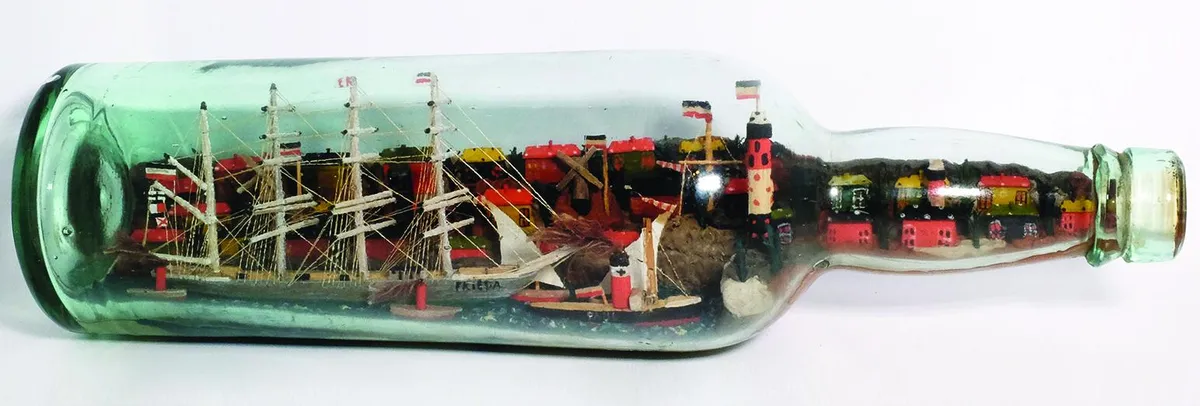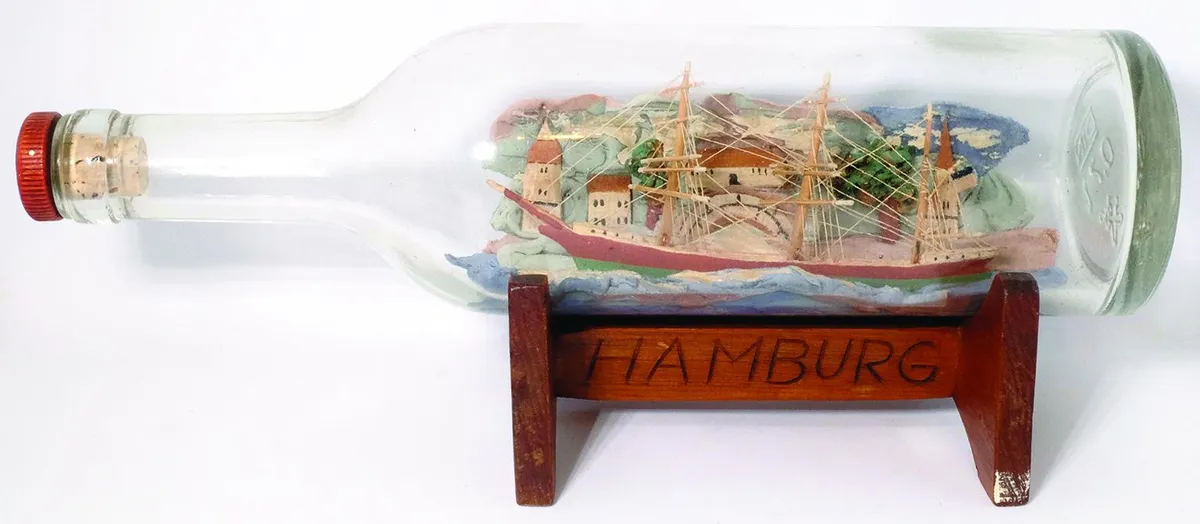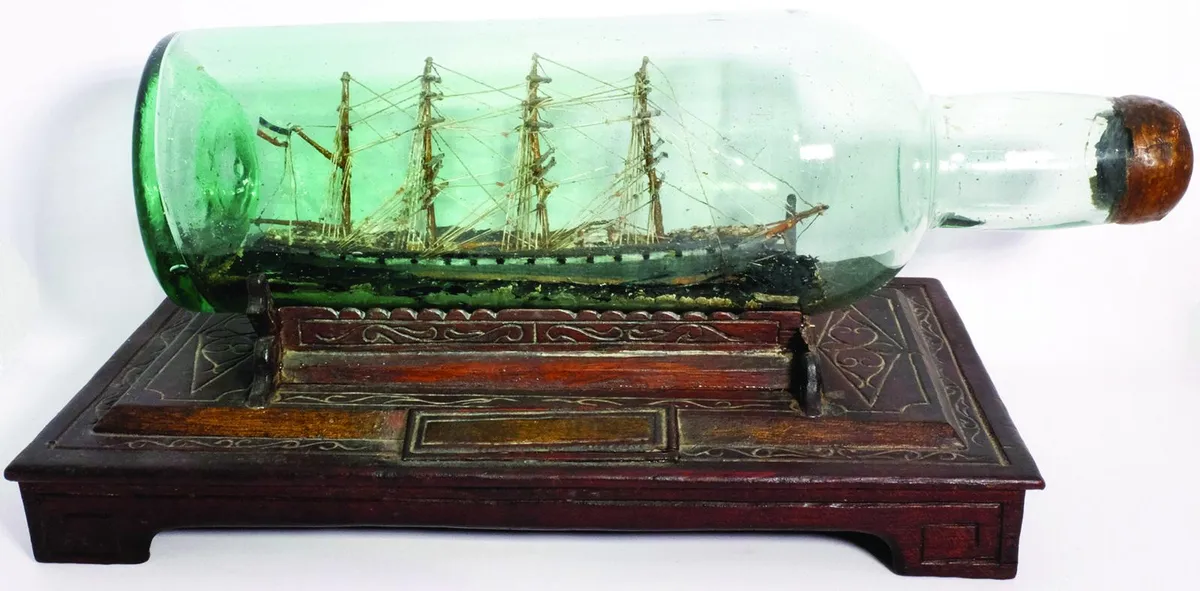An elegant square-rigged sailing ship – the ‘Frieda’ – glides majestically into port, past rows of colourful cottages perched on the cliffs around the harbour. Her sails are down and there’s a small tug boat guiding her inland. A flag on top of a nearby lighthouse flutters in the breeze and waves lap against the rocks as the ship approaches home. It’s a mesmerising scene and just one of the many moments captured forever in miniature-model form inside the 70 antique ships in bottles in dealer Robin Langford’s personal collection.
The art of making tiny ship models and inserting them in bottles is a craft that’s long been a maritime tradition. The exact origins of the practice are unknown, but Peter Bradshaw, President of the European Association of Ships in Bottles, thinks they may have evolved from a medieval custom of making crucifixion scenes in bottles. ‘I’ve got Dutch, German, French and British ships in bottles in my collection. The oldest ones I have date from the early 1800s, but there are some rare ones out there that date from the 1700s,’ says Robin. ‘The craft was at its peak during the merchant square rig sailing ship era (1870s to 1940s) and most of the antique ships in bottles on the market today date from this time.’
Before steam ships came along, boats relied entirely on wind power. ‘You couldn’t guarantee how quickly a sailing ship would travel,’ explains Robin. ‘Sailors worked in watches so they had a lot of time at sea with not much to do. They did all sorts of handicrafts to pass the days away, such as making ships in bottles. They were often given as love tokens, or gifts for relatives back home, or sold in port to raise a bit of extra money. Knitting, scrimshaw and painting were also popular pastimes.’

Ships in bottles were rarely marked or dated. However, some feature specific flags or even recognisable ports in the more intricate examples, with incredible diorama backgrounds including trees, buildings, lighthouses and windmills, so experts can sometimes work out roughly where the crafter had sailed from. Contrary to popular belief, it wasn’t always just sailors who made them, either. ‘Sometimes lighthouse keepers made ships in bottles, too,’ reveals Peter. ‘Like sailors, they also had long periods of time gazing out to sea with nothing to do!’
You might also like an 18th-century barn conversion filled with nautical antiques
Empty drinks bottles – mostly rum or whisky – were used to make these maritime creations. ‘Some were made in bottles that were damaged – whatever they could get their hands on,’ says Robin. ‘There are examples where the neck has been broken off and the sharp edges have been sanded off using ray or shark skin, which acts like sandpaper.’ At sea, sailor-makers faced many practical challenges. ‘Available materials were limited. They couldn’t just pop to a shop and buy a tin of paint, so they had to be creative,’ points out Peter. ‘A ship floating about on the ocean was probably not the ideal place to do such accurate work either,’ he adds. ‘Crafting a ship in a bottle requires intense concentration.’
Innovative sailors used plumber’s putty to make the ‘sea’ in the bottom of the bottle, which also held the ship firmly in place and included small chippings of real rocks and shells. Rigging was made from cotton sewing thread or rope fibres and there are rumours that they even sometimes used old biscuits in their models. Robin, a former sailor and now a full-time RNLI lifeguard, made a ship in a bottle himself when he was at sea in the South Pacific. His father – also a seafaring man – taught him the techniques required and he in turn had been taught by ‘an old boy’ who first went to sea aged 12.

At first glance, they seem to be impossible creations – how does the ship get inside when the opening is so tiny? Robin shares the secret: ‘You whittle the hull out from a small piece of scrap wood, shape it with a knife and sandpaper, then make the masts the same way,’ he explains. ‘You hinge the masts and fold everything down, slide the ship into position, then you have one line of thread that comes up through the neck which you pull gently to erect the masts. It’s all done with a tool made out of a flat piece of metal with a bend on the end – a prong on one side and a flat spade on the other.’
Peter’s tool of choice is simply a long piece of wire with a bend in the end. ‘Enthusiasts are always trading tips and techniques,’ he says. ‘Part of the appeal of making a ship in a bottle is solving problems.’ Collector and dealer Robin says typical prices vary from £35 for a more recent ship in a bottle up to around £600 for a rare, old example.
You might also like how to decorate with nautical antiques
‘Antique sailor-made ships in bottles are very under-valued in my opinion and under-appreciated,’ he says. ‘To me, it’s the number one sailor folk art. If you think of the skill and the time it took to make one – hundreds of hours – and the actual working knowledge of the ship required (because you can only make one if you understand exactly how the ship works) – they’re incredible. Scrimshaw (where sail needles were used to scratch pictures on whale teeth or bones) is nothing compared to making ships in bottles in terms of time and skill, yet scrimshaw is very collectable and expensive today.’

There are plenty of modern repro ships in bottles floating around, but they’re ‘worlds apart’ from the originals, according to Robin. ‘Repros often have paper sails and look quite crude. They don’t resemble the true shape and proportions of a sailing ship, so they look clunky. Most of the real sailor-made ones don’t have sails on them because they’re shown coming in to port without the sails set – they were ‘home coming’ scenes made by homesick sailors.’
Aside from the obvious risk of the bottle getting broken, antique ships in bottles are fragile and prone to damage. ‘The ship can become dislodged in the bottle and shaken around,’ reveals Robin. ‘When I pack them to post to a customer, I always triple-box them!’ Peter agrees that these delicate antiques require special care. ‘A bottle is like a miniature greenhouse,’ he explains. ‘If it’s kept in sunlight – on a window sill for example – it tends to heat up and the contents can become very brittle. If you try to restore one that’s been subjected to a lot of sunlight, when you open it up, the ship can just crumble to dust.’
Writing in Sea History magazine (in 1994), Professor Louis Arthur Norton, collector of marine artefacts, summed up the appeal of these antiques: ‘They are provocative and puzzling pebbles left on the sand from the ebb of the tide of time for us to collect, preserve, study and enjoy.’ Despite this, there’s a danger the art of making ships in bottles will soon die out. ‘Nowadays people just don’t have the time,’ says Robin. ‘They take too long to make.’ For enthusiasts, nothing beats the escapism of losing yourself in a miniature maritime scene. One imagines that lonely wives and mothers, when their husbands or sons were at sea for months on end, would stare into their bottle gifts fondly, too, imagining their loved ones’ safe return home.

